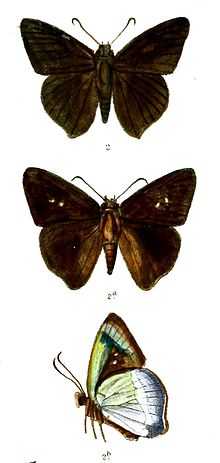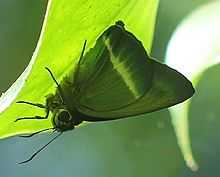Hasora taminatus
| White Banded Awl | |
|---|---|
 | |
| H. t. malayana (male, female and female underside) | |
| Scientific classification | |
| Kingdom: | Animalia |
| Phylum: | Arthropoda |
| Class: | Insecta |
| Order: | Lepidoptera |
| Family: | Hesperiidae |
| Genus: | Hasora |
| Species: | H. taminatus |
| Binomial name | |
| Hasora taminatus (Hübner, 1818)[1] | |
Hasora taminatus,[2][3] commonly known as the White Banded Awl, is a butterfly belonging to the family Hesperiidae, which is found in Asia.
Range
The butterfly is found in Sri Lanka, India, Myanmar, Thailand, Laos, Hainan, Hong Kong, Western China, Malaysia, the Indonesian archipelago (Borneo, Sumatra, Java, Nias, Sumbawa and Bali), Philippines and Sulawesi.
In India the butterfly is found in South India, where it occurs in the Western Ghats, Kodagu, Nilgiri mountains and Palni hills; and in the Himalayas from Mussoorie eastwards to Sikkim and through to Myanmar. It is also found in the Andaman and Nicobar islands.[3][4]
The type locality is South India.[3]

Status
'Common' in South India; 'Not Rare' elsewhere as per Evans (1932).[4]
Description
- For a key to the terms used see the glossary of Lepidopteran terms.
The butterfly, which has a wingspan of 45 to 55mm, is dark brown and unmarked above; and resembles the Common Banded Awl Hasora chromus, except that it has a broad white band on the under hindwing which is sharply defined. The female White Banded Awl has small spots on the upper forewing while the male has no brand above.[5][6]
Detailed description
Watson (1891) gives detailed descriptions of Hasora taminatus malayana, shown below:[7]
Alls supra fuscis, subtus anticarum limbo costali, posticarum dimidio basali chalybaeis, his striga discali alba.—(Felder, I. c.)
- "The females have a small semi-transparent yellowish discal speck between the two posterior branches of the median vein, and of course lack the oblique band of short lines of modified scales seen in the males of this as well as of the preceding closely-allied species." (Wood-Mason and de Niceville, J. A. S. B., 1881, p. 254.)
- The above refers to Andaman females only, as in the Nicobar females the small semi-transparent yellow discal speck between the two posterior branches of the median vein is wanting according to Messrs. Wood-Mason and de Niceville.
- Recorded from the Andamans and Nicobars.
Host-plants
The larva has been recorded on Derris scandens and Pongamia spp.[3]
Cited references
- ↑ Card for Hasora taminatus in LepIndex. Accessed 12 October 2007.
- ↑ TOL web page on genus Hasora
- ↑ 3.0 3.1 3.2 3.3 Marrku Savela's Website on Lepidoptera. Page on genus Hasora.
- ↑ 4.0 4.1 Evans,W.H.(1932) The Identification of Indian Butterflies, ser no I1.15, pp 316.
- ↑ Wynter-Blyth, M.A. (1957) Butterflies of the Indian Region, pg 468.
- ↑ Kunte, Krushnamegh. (2000) Butterflies of Peninsular India, pg 192.
- ↑ Watson, E. Y. (1891) Hesperiidae Indicae: Descriptions of the Hesperiidae of India, Burma and Ceylon. Vest and Co. Madras. [Under Parata malayana Felder]
See also
- Coeliadinae
- Hesperiidae
- List of butterflies of India (Coeliadinae)
- List of butterflies of India (Hesperiidae)
References
- Evans, W.H. (1932) The Identification of Indian Butterflies. 2nd Ed, (i to x, pp454, Plates I to XXXII), Bombay Natural History Society, Mumbai, India.
- Kunte, Krushnamegh. (2000) Butterflies of Peninsular India, (i to xviii, pp254, Plates 1 to 32) Universities Press (India) Ltd, Hyderabad (reprint 2006). ISBN 81-7371-354-5.
- Watson, E. Y. (1891) Hesperiidae indicae. Vest and Co. Madras.
- Wynter-Blyth, M.A. (1957) Butterflies of the Indian Region, Bombay Natural History Society, Mumbai, India.
Online
- Beccaloni, G. W., Scoble, M. J., Robinson, G. S. & Pitkin, B. (Editors). 2003. The Global Lepidoptera Names Index (LepIndex). World Wide Web electronic publication. (accessed 22 September 2007).
- Brower, Andrew V. Z., (2007). Hasora Moore 1881. Version 21 February 2007 (under construction). Page on genus Hasora in The Tree of Life Web Project http://tolweb.org/.
- Savela, Marrku Website on Lepidoptera (accessed 22 September 2007)